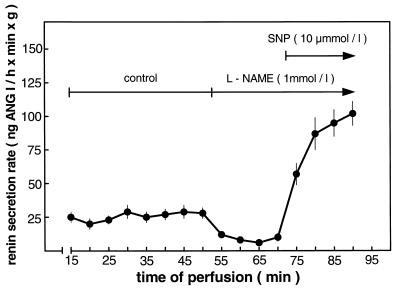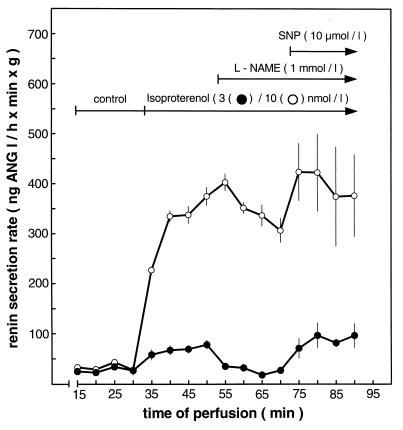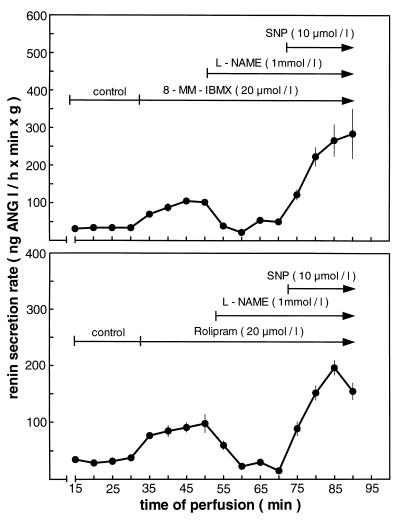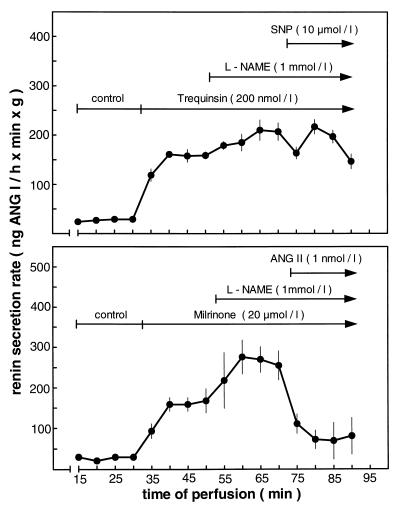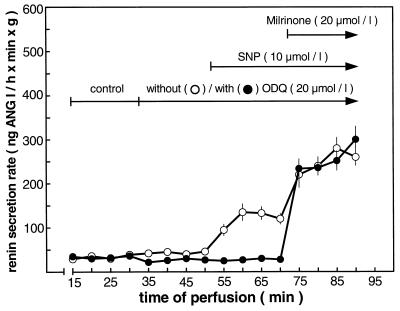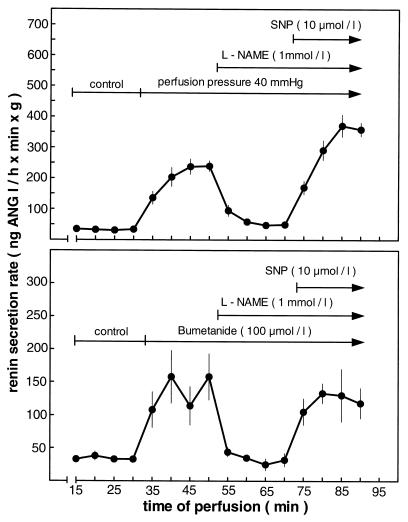Abstract
This study aimed to characterize the cellular pathways along which nitric oxide (NO) stimulates renin secretion from the kidney. Using the isolated perfused rat kidney model we found that renin secretion stimulated 4- to 8-fold by low perfusion pressure (40 mmHg), by macula densa inhibition (100 μmol/liter of bumetanide), and by adenylate cyclase activation (3 nmol/liter of isoproterenol) was markedly attenuated by the NO synthase inhibitor nitro-l-arginine methyl ester (l-Name) (1 mM) and that the inhibition by l-Name was compensated by the NO-donor sodium nitroprusside (SNP) (10 μmol/liter). Similarly, inhibition of cAMP degradation by blockade of phosphodiesterase 1 (PDE-1) (20 μmol/liter of 8-methoxymethyl-1-methyl-3-(2-methylpropyl)xanthine) or of PDE-4 (20 μmol/liter of rolipram) caused a 3- to 4-fold stimulation of renin secretion that was attenuated by l-Name and that was even overcompensated by sodium nitroprusside. Inhibition of PDE-3 by 20 μmol/liter of milrinone or by 200 nmol/liter of trequinsin caused a 5- to 6-fold stimulation of renin secretion that was slightly enhanced by NO synthase inhibition and moderately attenuated by NO donation. Because PDE-3 is a cGMP-inhibited cAMP-PDE the role of endogenous cGMP for the effects of NO was examined by the use of the specific guanylate cyclase inhibitor 1-H-(1,2,4)oxodiazolo(4,3a)quinoxalin-1-one (20 μmol). In the presence of 1H-[1,2,4]oxodiazolo[4,3-a]quinoxalin-1-one the effect of NO on renin secretion was abolished, whereas PDE-3 inhibitors exerted their normal effects. These findings suggest that PDE-3 plays a major role for the cAMP control of renin secretion. Our findings are compatible with the idea that the stimulatory effects of endogenous and exogenous NO on renin secretion are mediated by a cGMP-induced inhibition of cAMP degradation.
Because renal juxtaglomerular (JG) cells as the organism’s main site of renin production are surrounded by cells with a high capacity for NO formation such as endothelial cells and macula densa cells (1, 2) the influence of NO on renin expression and renin secretion has been investigated in a series of in vivo and in vitro experiments. With only one exception (3), renin secretion and renin gene expression in vivo have been found to be attenuated by NO synthase inhibitors in conscious (4–7) and anesthetized animals (8–10) and in isolated perfused kidneys (11). Conversely, NO donors were reported to stimulate renin secretion in vivo and in isolated kidneys (11–14), suggesting that on the level of the kidney NO acts as a stimulator of renin secretion. The pathways along which NO could stimulate renin secretion are poorly understood. The best-characterized general intracellular signaling pathway of NO comprises the stimulation of soluble guanylate cyclase, leading to an increase of intracellular cGMP levels and to the induction of cGMP-induced reactions (15). Surprisingly, activators of cGMP-dependent protein kinases inhibit renin secretion not only in isolated JG cells but also in isolated perfused kidneys and even inhibit NO-stimulated renin secretion there (14, 16, 17), suggesting (i) that G-kinase activation unlikely accounts for the stimulatory effect of NO on renin secretion and (ii) that NO could, in principle, also inhibit renin secretion via G-kinase activation. In fact, for more isolated experimental preparations such as kidney slices or isolated JG cells not only stimulation but also inhibition of renin secretion by NO has been reported (18–23). A possible explanation for such divergent effect of NO in intact kidneys and in isolated JG cells could be a complex signaling mechanism that also depends on factors different from NO itself.
In this context we recently found that the stimulatory effect of NO on renin secretion in isolated perfused kidneys was markedly attenuated when cAMP-dependent kinase was inhibited (14). Because cAMP is the best-established second messenger stimulating renin secretion from JG cells, it is conceivable that a linkage of NO with the cAMP pathway could account for the stimulatory effect of NO on renin secretion. In principle, NO could cause a stimulation of A kinase either through a transactivation of the kinase by cGMP (24) or through a cGMP-induced inhibition of cAMP degradation via cAMP-phosphodiesterase 3 (PDE-3) (24, 25). From in vivo data, Reid and associates already have proposed and developed the hypothesis that NO could stimulate renin secretion via inhibition of PDE-3 (refs. 4, 26, and 27). In view of these recent findings it appeared of interest to us therefore to characterize in the isolated perfused rat kidney whether NO-induced stimulation of renin secretion can be explained either by a NO/cGMP-induced transactivation of A kinase or by inhibition of cAMP degradation.
MATERIALS AND METHODS
Isolated Perfused Rat Kidney.
Male Sprague–Dawley rats (250–300 g body weight) having free access to commercial pellet chow and tap water were obtained from the local animal facilities and used throughout. Kidney perfusion was performed in a recycling system (28). In brief, the animals were anesthetized with 150 mg/kg of 5-ethyl-(1′-methyl-propyl)-2-thiobarbituric acid (Inactin, Byk-Gulden Pharmazeutika). Volume loss during the preparation was substituted by intermittent injections of physiological saline via a catheter inserted into the jugular vein. After opening of the abdominal cavity by a mid-line incision, the right kidney was exposed and placed in a thermoregulated metal chamber. The right ureter was cannulated with a small polypropylene tube (PP-10), which was connected to a larger polyethylene catheter (PE-50). After intravenous heparin injection (2 units/g) the aorta was clamped distal to the right renal artery, and the large vessels branching off the abdominal aorta were ligated. A double-barreled cannula was inserted into the abdominal aorta and placed close to the origin of the right renal artery. After ligation of the aorta proximal to the right renal artery the aortic clamp was quickly removed, and perfusion was started in situ with an initial flow rate of 8 ml/min. The right kidney was excised and perfusion at constant pressure (100 mmHg) was established. To this end the renal artery pressure was monitored through the inner part of the perfusion cannula (Statham Transducer P 10 EZ), and the pressure signal was used for feedback control of a peristaltic pump. The perfusion circuit was closed by draining the venous effluent via a metal cannula back into a reservoir (200–220 ml). The basic perfusion medium, which was taken from a thermostated (37°C) reservoir, consisted of a modified Krebs–Henseleit solution containing: all physiological amino acids in concentrations between 0.2 and 2.0 mM, 8.7 mM glucose, 0.3 mM pyruvate, 2.0 mM l-lactate, 1.0 mM α-ketoglutarate, 1.0 mM l-malate, and 6.0 mM urea. The perfusate was supplemented with 6 g/100 ml of BSA, 1 milliunit/100 ml of vasopressin 8-lysine, and with freshly washed human red blood cells (10% hematocrit). Ampicillin (3 mg/100 ml) and floxacillin (3 mg/100 ml) were added to inhibit possible bacterial growth in the medium. To improve the functional preservation of the preparation, the perfusate was continuously dialyzed against a 25-fold volume of the same composition but lacking erythrocytes and albumin. For oxygenation of the perfusion medium the dialysate was gassed with a 95% oxygen/5% carbon dioxide mixture. Under these conditions both glomerular filtration and filtration fraction remain stable for at least 90 min at values of about 1 ml/min × g and 7%, respectively (28).
Perfusate flow rates were obtained from the revolutions of the peristaltic pump, which was calibrated before and after each experiment. Renal flow rate and perfusion pressure were continuously monitored by a potentiometric recorder. Stock solutions of the drugs to be tested were dissolved in freshly prepared perfusate and infused into the arterial limb of the perfusion circuit directly before the kidneys at 3% of the rate of perfusate flow. For determination of perfusate renin activity, aliquots (about 0.1 ml) were drawn from the arterial limb of the circulation and the renal venous effluent, respectively. The samples were centrifuged at 1,500 × g for 15 min, and the supernatants were stored at −20°C until assayed for renin activity.
Experiments on Renin Secretion from Isolated Perfused Kidneys and Presentation of Results.
After establishing the reperfusion loop, perfusate flow rates usually stabilized within 15 min. Samples for the determination of renin activity were taken in 5-min intervals. Renin secretion rates were calculated from the arterio-venous differences of renin activity and the perfusate flow rate. The perfusate samples were diluted 1:5 in buffer and were incubated for 1.5 h at 37°C with plasma from bilaterally nephrectomized male rats as renin substrate. The generated angiotensin I (ANGI) was determined by radioimmunoassay (Sorin, Biomedica, Düsseldorf, Germany).
Five kidneys were used for each experimental protocol.
Statistics.
For evaluating the significance of changes of renin secretion induced by a certain experimental maneuver, all renin secretion rates obtained within this experimental period (normally four values) were averaged and compared with the average values of renin secretion of the preceding period. Student’s paired t test was used to calculate levels of significance, and P < 0.05 was considered significant.
RESULTS
Basal renin secretion from all the kidneys considered in this study ranged between 20 and 40 ng ANGI/h × min × g. Basal renin secretion was significantly attenuated to 30% of the basal value when the NO-synthase inhibitor nitro-l-arginine methyl ester (l-Name) (1 mmol/liter) was added to the perfusate (P < 0.05) (Fig. 1). The NO-donor sodium nitroprusside (SNP) (10 μmol/liter) not only restored renin secretion in the presence of l-Name but even increased renin secretion rates 3-fold over the basal secretion rates (P < 0.05) (Fig. 1).
Figure 1.
Effect of l-Name and SNP on renin secretion from isolated rat kidneys perfused at 100 mmHg. Samples were taken in 5-min intervals during the different experimental periods, the duration of which is indicated in the upper part of the figure. For determination of significant differences renin secretion rates obtained within a certain experimental period of each kidney were taken together and averaged. The experimental protocols were run with five different kidneys. Data are means +/− SEM.
Isoproterenol, which is known to activate adenylate cyclase in JG cells, stimulated renin secretion about 3-fold at a low concentration of 3 nmol/liter (P < 0.05) (Fig. 2). Addition of 1 mmol/liter of l-Name in the presence of 3 nmol of isoproterenol lowered renin secretion rates to near basal levels (P < 0.05) (Fig. 2). Addition of 10 μmol/liter of SNP in the presence of both isoproterenol and l-Name completely restored renin secretion (P < 0.05) (Fig. 2). From our experience a maximal cAMP-related stimulation of renin secretion from the isolated rat kidney can be achieved with 10 nmol/liter of isoproterenol. At that concentration isoproterenol stimulated renin secretion rates about 11-fold (P < 0.05) (Fig. 2). Addition of l-Name in the presence of the high concentration of isoproterenol led to a delayed decline of renin secretion, which was restored by addition of SNP (Fig. 2).
Figure 2.
Effect of l-Name and SNP in the presence of lower (3 nmol/liter) and higher (10 nmol/liter) concentrations of isoproterenol on renin secretion from isolated rat kidneys perfused at 100 mmHg. Samples were taken in 5-min intervals during the different experimental periods, the duration of which is indicated in the upper part of the figure. For determination of significant differences renin secretion rates obtained within a certain experimental period of each kidney were taken together and averaged. The experimental protocols were run with five different kidneys. Data are means +/− SEM.
We next examined the efficacy of NO on renin secretion during states of inhibited cAMP degradation. The group of cAMP PDEs comprises four subfamilies (PDE-1, -2, -3, and -4), and specific inhibitors for PDE-1, -3, and -4 are available (25).
8-Methoxymethyl-1-methyl-3-(2-methylpropyl)xanthine (8-MM-IBMX) (20 μM) was used to inhibit the calcium regulated PDE-1 (25). This drug caused a 3-fold stimulation of basal renin secretion (P < 0.05) (Fig. 3, Upper). The stimulation of renin secretion by 8-MM-IBMX was reduced to basal levels by l-Name (P < 0.05) and was even overcompensated by SNP (P < 0.05) (Fig. 3, Upper). Similarly, inhibition of PDE-4 by 20 μmol/liter of rolipram (25) stimulated basal renin secretion about 3-fold (P < 0.05) (Fig. 3, Lower). Again, the stimulation by rolipram was substantially attenuated by l-Name (P < 0.05) and was overcompensated by SNP (P < 0.05) (Fig. 3, Lower). PDE-3 activity was inhibited with lower concentrations of trequinsin (200 nmol/liter) (29), which caused a 5-fold stimulation of basal renin secretion (P < 0.05) (Fig. 4, Upper). In the presence of trequinsin, l-Name tended to even further increase renin secretion whereas addition of SNP in the continuous presence of trequinsin and l-Name appeared to moderately decrease renin secretion rates (Fig. 4, Upper). To test for the possibility that trequinsin may have caused a nonspecific activation of renin secretion, we further considered the effect of milrinone, which also is considered as a classic inhibitor of PDE-3 (25). Like trequinsin, 20 μmol/liter of milrinone stimulated renin secretion about 5- to 6-fold (P < 0.05) (Fig. 4, Lower). l-Name further increased renin secretion in the presence of milrinone (P < 0.05) (Fig. 4, Lower). In the presence of both milrinone and l-Name, 1 nmol/liter of ANGI induced a potent inhibition of renin secretion (P < 0.05), suggesting that renin secretion was, in principle, able to be regulated during PDE-3 blockade.
Figure 3.
Effect of l-Name and SNP in the presence of 8-methoxymethyl-1-methyl-3-(2-methylpropyl)xanthine (8-MM-IBMX) (Upper) and in the presence of rolipram (Lower) on renin secretion from isolated rat kidneys perfused at 100 mmHg. Samples were taken in 5-min intervals during the different experimental periods, the duration of which are indicated in the upper parts of each panel. For determination of significant differences renin secretion rates obtained within a certain experimental period of each kidney were taken together and averaged. The experimental protocols were run with five different kidneys. Data are means +/− SEM.
Figure 4.
(Upper) Effect of l-Name and SNP in the presence of trequinsin (200 nmol/liter) on renin secretion from isolated rat kidneys perfused at 100 mmHg. (Lower) Effect of l-Name and ANGI in the presence of 20 μmol/liter of milrinone on renin secretion from isolated rat kidneys perfused at 100 mmHg. Samples were taken in 5-min intervals during the different experimental periods, the duration of which is indicated in the upper parts of the panels. For determination of significant differences renin secretion rates obtained within a certain experimental period of each kidney were taken together and averaged. The experimental protocols were run with five different kidneys. Data are means +/− SEM.
Because PDE-3 is considered the cGMP-inhibitive form of cAMP-PDEs, we next considered the relevance of cGMP for the effect of NO on renin secretion. For this purpose we used 1H-[1,2,4]oxodiazolo[4,3-a]quinoxalin-1-one (ODQ), which is an established inhibitor of NO-induced guanylate cyclase activity (30). As shown in Fig. 5, 20 μmol/liter of ODQ alone caused a moderate inhibition of renin secretion. In combination with SNP it prevented any stimulation of renin secretion, whereas it did not modify the stimulation of the PDE-3 inhibitor milrinone (P < 0.05) (Fig. 5). Fig. 5 also shows control experiments with SNP and milrinone in the absence of ODQ, demonstrating that milrinone further increased the stimulatory effect of SNP (P < 0.05) and that the degree of stimulation induced by milrinone was the same in the presence and in the absence of ODQ.
Figure 5.
Effect of SNP and milrinone in the absence (○) and in the presence (•) of 20 μmol/liter of ODQ on renin secretion from isolated rat kidneys perfused at 100 mmHg. Samples were taken in 5-min intervals during the different experimental periods, the duration of which is indicated in the upper part of the figure. For determination of significant differences renin secretion rates obtained within a certain experimental period of each kidney were taken together and averaged. The experimental protocols were run with five different kidneys. Data are means +/− SEM.
Experiments with the isolated perfused kidney cannot distinguish between direct and indirect effect of drugs on renin secretion from the JG cells. The most relevant mechanisms mediating indirect effects on renin secretion in isolated kidneys comprise the baroreceptor mechanism and the macula densa mechanism (31). It therefore was of interest to examine whether the effects of the PDE-3 inhibitors on renin secretion could, in principle, be explained by the baroreceptor or the macula densa pathway. Because the most striking feature of renin stimulation by PDE-3 inhibition was its apparent insensitivity to changes of NO, we considered the role of NO for baroreceptor and for macula densa stimulated renin secretion. As shown in Fig. 6 (Upper) reduction of the renal perfusion pressure from 100 mmHg to 40 mmHg led to an 8-fold stimulation (P < 0.05) of basal renin secretion. This stimulation by low pressure was substantially attenuated by l-Name (P < 0.05) and was overcompensated by SNP (P < 0.05). Inhibition of macula densa transport function by the loop diuretic bumetanide (100 μmol/liter) stimulated renin secretion about 4-fold (P < 0.05) (Fig. 6, Lower). Renin secretion was lowered to basal levels by l-Name (P < 0.05) and was completely restored by SNP (P < 0.05) (Fig. 6, Lower).
Figure 6.
Effect of l-Name and SNP at low perfusion pressure (Upper) and in the presence of 100 μmol/liter of bumetanide (Lower) on renin secretion from isolated perfused rat kidneys. Samples were taken in 5-min intervals during the different experimental periods, the duration of which is indicated in the upper panel of the figure. For determination of significant differences renin secretion rates obtained within a certain experimental period of each kidney were taken together and averaged. The experimental protocols were run with five different kidneys. Data are means +/− SEM.
DISCUSSION
This study aimed to characterize the role of the cAMP pathway for the stimulatory effect of NO on renin secretion from the kidney. Our findings show that basal renin secretion as well as renin secretion stimulated by adenylate cyclase activation via isoproterenol are sensitive to changes of NO. It appears therefore that activation of cAMP formation is a less likely mechanism to account for the stimulatory effect of NO on renin secretion. In fact, stimulation of adenylate cyclase activity by NO has not yet been reported. Our findings also show that interference with the cAMP-degrading enzymes PDE-1 and PDE-4 is also less likely to explain the effect of NO on renin secretion, because renin secretion during inhibition of PDE-1 and PDE-4 turned out to be highly sensitive to changes of NO. In contrast, inhibition of PDE-3 activity appeared to mimic the effect of NO on renin secretion in a way that it potently stimulated basal renin secretion and that it rendered renin secretion insensitive toward changes of NO. A link between PDE-3 and NO is given by the fact that PDE-3 is a cGMP-inhibited cAMP PDE (25) and that NO almost ubiquitously increases cellular cGMP levels via the stimulation of soluble guanylate cyclase (15). Indeed we found that inhibition of guanylate cyclase activity abolished the effect of NO on renin secretion, whereas the effect of PDE-3 inhibition on renin secretion was still preserved when guanylate cyclase activity was blocked. The conclusion that inhibition of PDE-3 could mediate the stimulatory effect of NO on renin secretion is supported by the fact that the effect of NO on renin secretion appeared to be reversed during PDE-3 inhibition in the way that inhibition of endogenous NO formation enhanced renin secretion whereas administration of the NO donor moderately attenuated renin secretion. This almost reverse effect of NO could be explained by an opposite control of renin secretion by A and G kinase (14). Once the stimulatory effect of NO on renin secretion has been cut short by PDE-3 inhibitors, the remaining effect of NO on renin secretion should be an inhibitory one related to G-kinase activation, which exerts a negative effect on renin secretion (14, 16, 17).
It is possible to infer from these findings that the stimulatory effect of NO on renin secretion is almost exclusively mediated by PDE-3, and this conclusion in fact confirms a concept recently developed by Reid and associates (4, 26, 27). Although our data do not allow us to unequivocally conclude that NO acts within renal JG cells by inhibiting PDE-3 we think that circumstantial evidence supports this assumption. First, our data render the possibility less likely that the stimulatory effect of PDE-3 inhibition was essentially mediated by indirect mechanisms such as the baroreceptor or macula densa mechanism. Second, in primary cultures of JG cells, SNP causes a moderate and delayed elevation of cellular cAMP levels (14, 19). Finally, cAMP is the best-established renin stimulatory second messenger within JG cells (31) and the stimulatory effect of NO on renin secretion recently has been found to be dependent on A-kinase activity (14).
An effect of NO on cAMP degradation indeed would provide an explanation for the observations that endogenous NO appears to act more as a general enhancer of the renin system rather than as a highly specific activator, which in turn is compatible with the almost ubiquitous presence of NO. Apart from demonstrating that PDE-3 is a likely mediator for the effects of NO on the renin system our findings also highlight the relevance of PDE-3 for the regulation of the renin system in general. Considering that activation of the adenylate cyclase causes a maximal 11-fold stimulation of renin secretion, a 6-fold stimulation by PDE-3 inhibition in the absence of exogenous activators of adenylate cyclase appears remarkable.
It therefore will be of interest for future experiments to study a possible physiologic regulation of PDE-3 expression in the kidney, in particular in the JG region, and to consider an altered expression of this enzyme family in the context of an altered activity of the renal renin system. A mediation of the stimulation of renin secretion by NO via PDE-3 also could provide a possible explanation for why the stimulation of renin secretion by NO in isolated JG cells occurs not as promptly as in the whole kidney. The efficacy of PDE-3 inhibition to increase intracellular cAMP levels will critically depend on the rate of cAMP formation, i.e., adenylate cyclase activity. One may assume that because of the lack of endogenous AC activators, such as prostaglandins, adrenomedullin, etc., adenylate cyclase activity in JG cells in culture is lower than in JG cells in situ in the whole kidney. Therefore PDE-3 inhibition may require a longer time in isolated JG cells than in situ to accumulate cAMP levels sufficient to stimulate renin secretion. Certainly, this suggestion will have to be tested in future cell culture experiments.
Acknowledgments
This study was financially supported by a grant from the Deutsche Forschungsgemeinschaft (Ku859/2–3).
Footnotes
This paper was submitted directly (Track II) to the Proceedings Office.
Abbreviations: PDE, phosphodiesterase; JG, juxtaglomerular; ODQ, 1H-[1,2,4]oxodiazolo[4,3-a]quinoxalin-1-one; l-Name, nitro-l-arginine methyl ester; SNP, sodium nitroprusside; ANGI, angiotensin I.
References
- 1.Bachmann S, Bosse H M, Mundel P. Am J Physiol. 1995;268:F885–F898. doi: 10.1152/ajprenal.1995.268.5.F885. [DOI] [PubMed] [Google Scholar]
- 2.Wilcox C S, Welch W J, Murad F, Gross S S, Taylor G, Levi R, Schmidt H H H W. Proc Natl Acad Sci USA. 1992;89:11993–11997. doi: 10.1073/pnas.89.24.11993. [DOI] [PMC free article] [PubMed] [Google Scholar]
- 3.Schnackenberg C G, Tabor B L, Strong M H, Granger J P. Am J Physiol. 1997;272:R879–R886. doi: 10.1152/ajpregu.1997.272.3.R879. [DOI] [PubMed] [Google Scholar]
- 4.Chiu T, Reid I A. J Pharmacol Exp Ther. 1996;278:793–799. [PubMed] [Google Scholar]
- 5.Knoblich P R, Freeman R H, Villareal D. Hypertension. 1996;28:738–742. doi: 10.1161/01.hyp.28.5.738. [DOI] [PubMed] [Google Scholar]
- 6.Persson P B, Baumann J E, Ehmke H, Hackenthal E, Kirchheim H R, Nafz B. Am J Physiol. 1993;264:F943–F947. doi: 10.1152/ajprenal.1993.264.6.F943. [DOI] [PubMed] [Google Scholar]
- 7.Schricker K, Hegyi I, Hamann M, Kaissling B, Kurtz A. Proc Natl Acad Sci USA. 1995;92:8006–8010. doi: 10.1073/pnas.92.17.8006. [DOI] [PMC free article] [PubMed] [Google Scholar]
- 8.Sigmon D H, Carretero O A, Beierwaltes W H. Am J Physiol. 1992;263:F256–F261. doi: 10.1152/ajprenal.1992.263.2.F256. [DOI] [PubMed] [Google Scholar]
- 9.Beierwaltes W H. Am J Physiol. 1995;269:F134–F139. doi: 10.1152/ajprenal.1995.269.1.F134. [DOI] [PubMed] [Google Scholar]
- 10.Johnson R A, Freeman R H. Am J Physiol. 1994;266:R1723–1729. doi: 10.1152/ajpregu.1994.266.6.R1723. [DOI] [PubMed] [Google Scholar]
- 11.Gardez J, Gonzalez M F, Alhenc-Gelas F, Menard J. Am J Physiol. 1994;267:F798–F804. doi: 10.1152/ajprenal.1994.267.5.F798. [DOI] [PubMed] [Google Scholar]
- 12.Scholz H, Kurtz A. J Clin Invest. 1993;91:1088–1094. doi: 10.1172/JCI116266. [DOI] [PMC free article] [PubMed] [Google Scholar]
- 13.Hackenthal E, Münter K, Fritsch S. Endothelium. 1994;2:229–237. [Google Scholar]
- 14.Kurtz, A., Götz, K. H., Hamann, M,, Kieninger, M. & Wagner, C. (1998) Am. J. Physiol., in press. [DOI] [PubMed]
- 15.Moncada S, Palmer R M J, Higgs E A. Pharmacol Rev. 1991;43:109–142. [PubMed] [Google Scholar]
- 16.Henrich W L, McAllister E A, Smith P B, Campbell W B. Am J Physiol. 1988;255:F474–F478. doi: 10.1152/ajprenal.1988.255.3.F474. [DOI] [PubMed] [Google Scholar]
- 17.Della Bruna R, Pinet F, Corvol P, Kurtz A. Kidney Int. 1995;47:1266–1273. doi: 10.1038/ki.1995.181. [DOI] [PubMed] [Google Scholar]
- 18.Noble A R, Abu-Kishk R A, Dálioa M A, Williams B C, Lush D J. Kidney Int. 1994;64:1588–1590. doi: 10.1038/ki.1994.454. [DOI] [PubMed] [Google Scholar]
- 19.Schricker K, Kurtz A. Am J Physiol. 1993;265:F180–F186. doi: 10.1152/ajprenal.1993.265.2.F180. [DOI] [PubMed] [Google Scholar]
- 20.Greenberg S G, He X R, Schnermann J B, Briggs J P. Am J Physiol. 1995;268:F948–F952. doi: 10.1152/ajprenal.1995.268.5.F948. [DOI] [PubMed] [Google Scholar]
- 21.Kurtz A, Della Bruna R, Pfeilschifter J, Taugner R, Bauer C. Proc Natl Acad Sci USA. 1986;83:4769–4773. doi: 10.1073/pnas.83.13.4769. [DOI] [PMC free article] [PubMed] [Google Scholar]
- 22.Beierwaltes W H. Hypertension. 1994;23:I40–I44. doi: 10.1161/01.hyp.23.1_suppl.i40. [DOI] [PubMed] [Google Scholar]
- 23.He X R, Greenberg S G, Briggs J P, Schnermann J B. Am J Physiol. 1995;268:F953–F959. doi: 10.1152/ajprenal.1995.268.5.F953. [DOI] [PubMed] [Google Scholar]
- 24.Butt E, Nolte C, Schulz S, Beltman J, Beavo J A, Jastorff B, Walter U. Biochem Pharmacol. 1992;43:2591–2600. doi: 10.1016/0006-2952(92)90148-c. [DOI] [PubMed] [Google Scholar]
- 25.Beavo J A. Physiol Rev. 1995;75:725–748. doi: 10.1152/physrev.1995.75.4.725. [DOI] [PubMed] [Google Scholar]
- 26.Reid I A, Bui H, Chou L. Hypertension. 1994;23:I49–I53. doi: 10.1161/01.hyp.23.1_suppl.i49. [DOI] [PubMed] [Google Scholar]
- 27.Chiu N, Park I, Reid I A. J Pharmacol Ther. 1996;276:1073–1077. [PubMed] [Google Scholar]
- 28.Scholz H, Kurtz A. Pflügers Arch. 1992;421:155–162. doi: 10.1007/BF00374822. [DOI] [PubMed] [Google Scholar]
- 29.Tang K M, Jang E K, Haslam R J. Eur J Pharmacol. 1994;202:201–211. doi: 10.1016/0922-4106(94)90125-2. [DOI] [PubMed] [Google Scholar]
- 30.Garthwite J, Southam E, Boulton C L, Nielsen E B, Schmid K, Mayer B. Mol Pharmacol. 1995;48:184–188. [PubMed] [Google Scholar]
- 31.Hackenthal E, Paul M, Ganten D, Taugner R. Physiol Rev. 1990;70:1067–1116. doi: 10.1152/physrev.1990.70.4.1067. [DOI] [PubMed] [Google Scholar]



